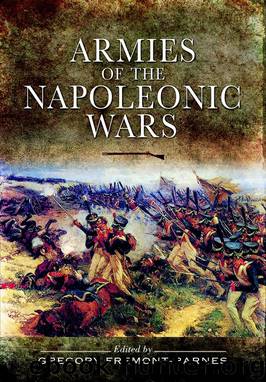Armies of the Napoleonic Wars by Gregory Fremont-Barnes

Author:Gregory Fremont-Barnes
Language: eng
Format: epub
ISBN: 9781783032082
Publisher: Pen and Sword
Published: 2013-05-28T16:00:00+00:00
CAVALRY
One of the most notable features of the British cavalry of this era was its numerical strength. Unlike the continental powers, Britain possessed a very small mounted corps, for in colonial warfare the terrain and climate often did not suit this arm, in amphibious operations the conveyance of cavalry was particularly problematic and until the middle of the Peninsular War the mounted arm was not required in larger numbers. Once the army grew in order to face the sizable French forces that Napoleon deployed in the Peninsula, the need for substantial numbers of cavalry naturally arose. In May 1809 there were only just over 3,000 cavalry in Portugal; there were about the same number at the Battle of Talavera in 1810 and fewer than 2,000 at Fuentes de Oñoro in the following year. While the overall strength of the cavalry rose over time, its relative proportion within the army remained about the same — around 10 per cent.
British cavalry at the start of the wars were divided into three types: the Household regiments; the dragoons, of which the senior version were the Dragoon Guards, which with the ordinary dragoon regiments were designated as ‘heavy’, as were the regiments in the Household Brigade; and the light dragoons, the difference being that the heavy dragoons were intended for use on the battlefield to execute the charge, whereas light cavalry, while also able to fight in pitched battles, could also perform duties like scouting, skirmishing and protecting baggage trains and lines of communications. In 1806, the army converted some light dragoon regiments into hussars, on the pattern of their continental equivalents that had proven themselves so effective in the eighteenth century. Like the infantry, the basic cavalry unit was the regiment, two or more of which formed a brigade, two or more of which composed a division. A regiment was itself subdivided into squadrons, and then of troops, with the number of troops varying depending on the official establishment at the time. Official strength was over 600 officers and men, though on campaign this often could not be met, and regiments frequently fell below 500.
When the Revolutionary Wars began, the heavy cavalry were armed with a rather unbalanced sabre which proved as inadequate for cutting as for thrusting. According to the 1796 manual that set out the principles of cavalry manoeuvre and the use of weapons, troopers were advised to employ the cut or slash in preference to the thrust used by most continental heavy cavalry. In 1796 the heavy cavalry were issued with a new pattern sabre, a heavy, unwieldy, blunt-pointed weapon that was retained through to Waterloo. If it made contact with its target in a downward stroke it caused dreadful injury, though it was less likely to kill an adversary than a thrust delivered by a French cavalryman.
British cavalry also carried firearms — various types of muskets and carbines — though these were even less effective than their infantry counterparts. Cumbersome and adding unnecessary additional weight to already heavily equipped
Download
This site does not store any files on its server. We only index and link to content provided by other sites. Please contact the content providers to delete copyright contents if any and email us, we'll remove relevant links or contents immediately.
| Africa | Americas |
| Arctic & Antarctica | Asia |
| Australia & Oceania | Europe |
| Middle East | Russia |
| United States | World |
| Ancient Civilizations | Military |
| Historical Study & Educational Resources |
Celtic Warfare: From the Fifth Century BC to the First Century AD by Gioal Canestrelli(407)
Armies of Dark Ages Europe, 613-987: Charlemagne, the Carolingians and Their Enemies by Gabriele Esposito(405)
Waterloo by Tim Clayton(274)
Armies of the Napoleonic Wars by Gregory Fremont-Barnes(263)
Journeys to England and Ireland by Alexis de Tocqueville(242)
Violence in Ulster : an oral documentary by Van Voris W. H(242)
Captives and Their Saviors in the Medieval Crown of Aragon by Jarbel Rodriguez(236)
War in Ukraine Volume 2: Russian Invasion, February 2022 (Europe@War) by Tom Cooper Adrien Fontanellaz Edward Crowther Milos Sipos(234)
A Polish Son in the Motherland : An American's Journey Home by Leonard Kniffel(222)
Medieval Bruges, c. 850–1550 by Brown Andrew & Dumolyn Jan(217)
The Sabotage Diaries by Katherine Barnes(212)
The Templars at War by Zvonimir Grbasic;(207)
Irish Historical Allusions, Curious Customs and Superstitions, County of Kerry, Corkaguiny by Patrick M. Foley(204)
The Bloody Red Hand by Derek Lundy(190)
Passage to Byzantium: The Romanov-Habsburg Feud that Led to World War I by Maggie Ledford Lawson(184)
The Medieval Soldier in the Wars of the Roses by Andrew Boardman;(179)
Holy Roman Empire Power Politics Papacy by Anne Davison(177)
Kicked Out of Heaven Vol. III: The Untold History of The White Races Cir. 700 - 1700 a.d. (The Dragon Book 3) by Keenan Booker(177)
The Great Shame: And The Triumph Of The Irish In The English -Speaking World by Thomas Keneally(170)
